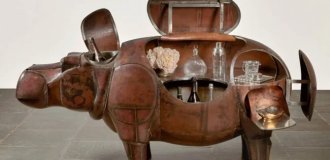A generous man who bought Stonehenge instead of chairs (9 photos)
On September 21, 1915, a lawyer named Cecil Chubb went to an auction. The reason was trivial: his wife asked him to buy some curtains. According to other sources, they were chairs. 
Actually, it doesn't matter. Because the man bought neither. Instead, Mr. Chubb returned home the proud owner of a crumbling stone monument. 
It's hard to imagine today that one of the world's most famous prehistoric monuments, Stonehenge, could be put up for sale at auction, but that's exactly what happened over a century ago. 
A recreation of the Stonehenge sale, originally held at Salisbury Theatre on 21 September 1915. Simon Kirk plays auctioneer Sir Howard Frank
Stonehenge had been in private hands since King Henry VIII confiscated it from a nearby Benedictine abbey in 1540. The monument changed hands several times until it was bought by the Antrobus family of Cheshire in 1824. In 1900, they fenced the monument and began charging an entrance fee of 1 shilling to pay for a guard and the restoration of the neglected ruins. Following the death of Sir Edmund Antrobus, the family's sole heir, in 1914, the estate was divided into lots and put up for auction. 
The Works Authority has begun work on rebuilding Stonehenge, which was given to the nation in 1918 by Mr Chubb of Salisbury. The stones are being protected by wooden supports while they are moved into place.
Lot 15: "Stonehenge with grounds approx. 30 acres, 2 yards, 37 perches" caught the eye of Cecil Chubb. Bidding began at £5,000 and rose by £100 to reach £6,000, but then stalled. No one was willing to pay more. 
Cecil Chubb with a not-so-pleased wife
"Gentlemen, it is impossible to value Stonehenge," the auctioneer argued. "Of course, £6,000 is bad, but if no one bids more, I will set that price. Surely no one will give me more than £6,000 for Stonehenge?" 
A view of the leaning stone before it was straightened
One by one, hands went up again. Someone had bid £6,500. But before the auctioneer could bring down the hammer, Mr Chubb had bid £6,600. Stonehenge was sold.
Chubb's wife was understandably unhappy, but Chubb couldn't help himself. "While I was in the room I thought it was a man from Salisbury who was going to buy it, and that's what happened," Chubb told the local paper. Chubb feared that a wealthy foreigner might buy Stonehenge, dismantle it, and move it overseas, as happened to London Bridge more than 50 years later when it was moved to Arizona. 
Three years later, Chubb donated Stonehenge to the British people, with the understanding that locals would be able to visit it for free. In a letter announcing the gift, Chubb wrote:
Stonehenge is perhaps the best known and most interesting of our national monuments, and has always evoked strong emotions in the British imagination. To me, who was born near it, and who in my youth had visited it at all hours of the day and night, in all weathers, in sleet, rain, and snow, in furious thunderstorms, in glorious moonlight and beautiful sunshine, it had always possessed an indescribable charm. I became its owner with a feeling of deep satisfaction, and expected that it would remain a treasured possession of my family for many years to come. But I had been led to believe that the nation would want it and would value it very highly. 
Farmer Richard Crook, grandson of second bidder Isaac Crook, with a copy of his grandfather's auction catalogue
Thanks to Chubb's impulsive purchase and generosity, Stonehenge was preserved for future generations.
Who knows what would have happened to it if someone else had bought it? It was in a pretty precarious state at the time, and Chubb appears to have been its saviour, stepping in to ensure Stonehenge remained in local ownership.
The second claimant to Stonehenge was farmer Isaac Crook, who wanted to graze sheep in the fields. His grandson Richard, who still farms nearby, told an interviewer: “He was going to graze sheep. The idea that our family might have owned Stonehenge is very interesting. But who knows what he would have done with the stones? He was interested in the land, not the stones, but I like to think he would have looked after them.” 
In 1919, the British government began a major reconstruction of Stonehenge, which involved straightening the stones and re-filling them with concrete. In the late 1920s, a nationwide appeal was launched to save Stonehenge from the modern buildings that had begun to rise around it. By 1928, the National Trust had bought the land around the monument and removed the buildings.





















